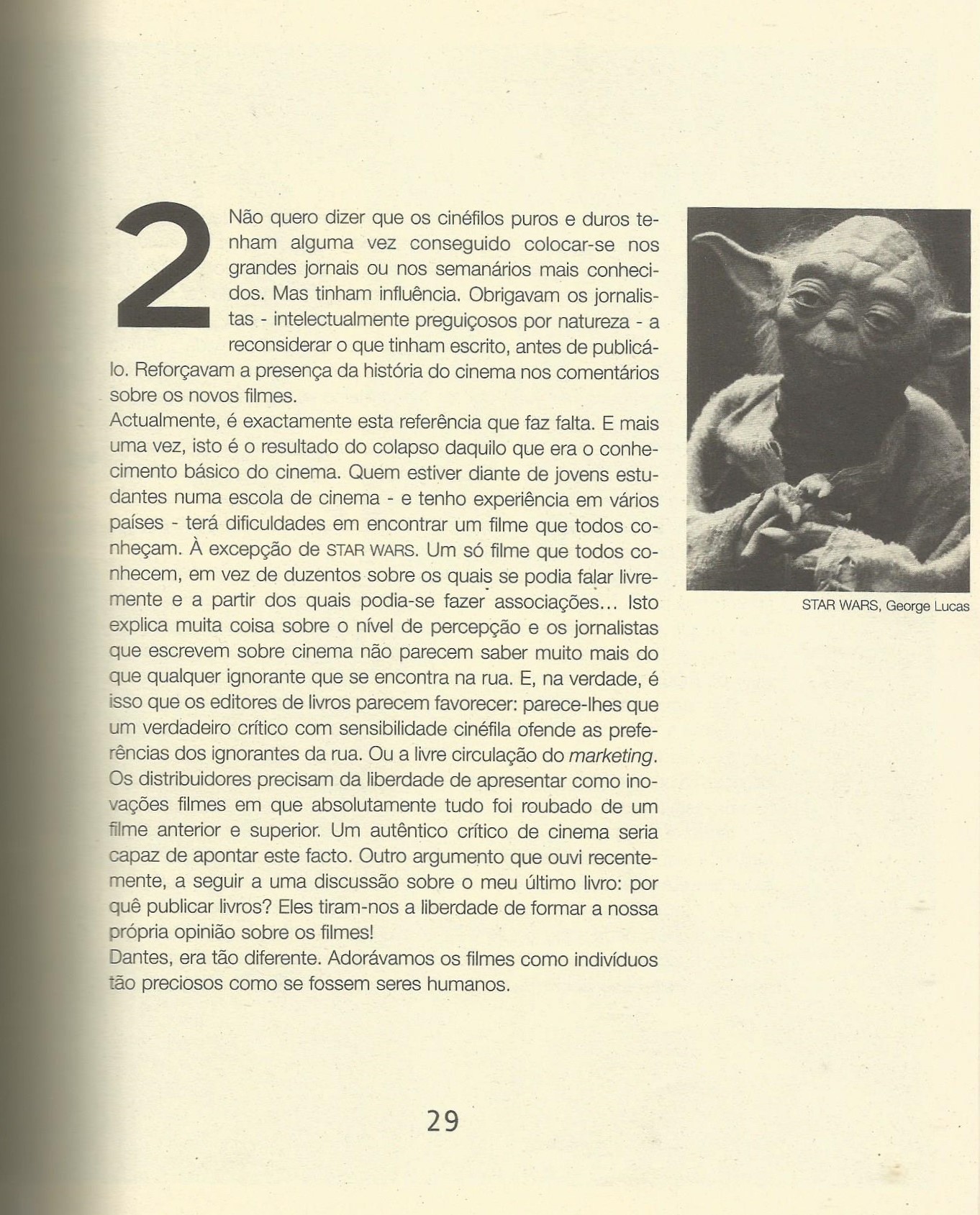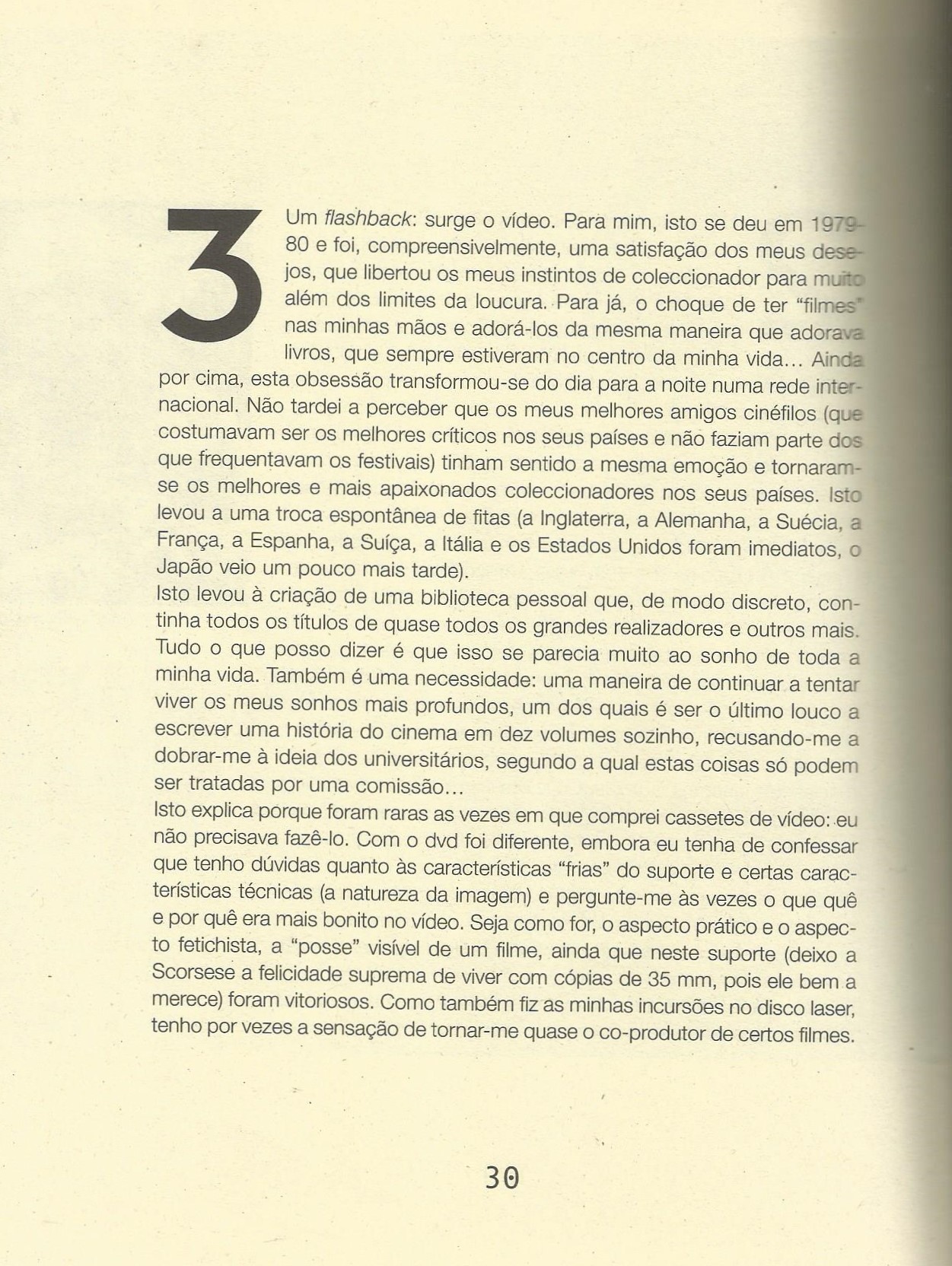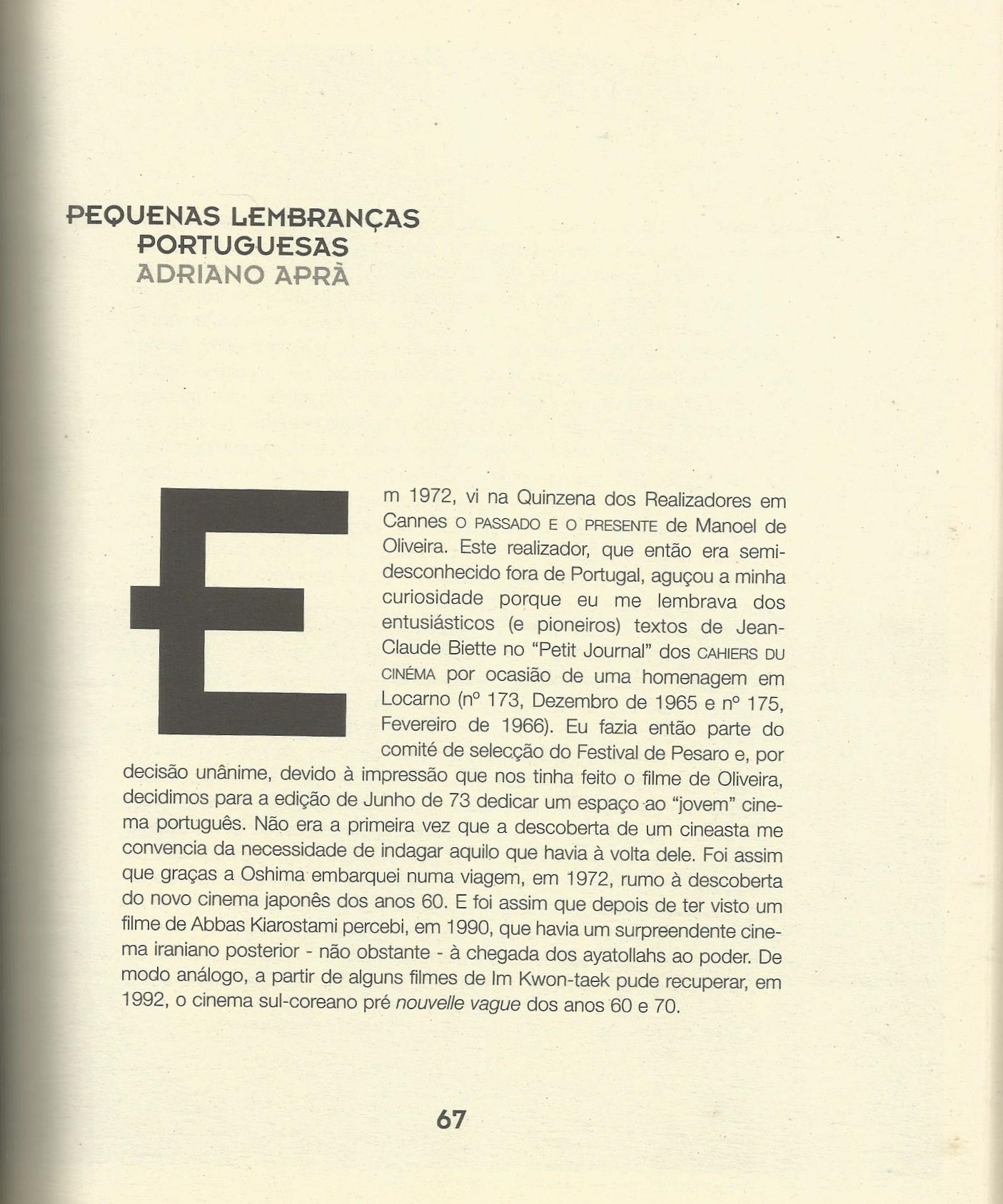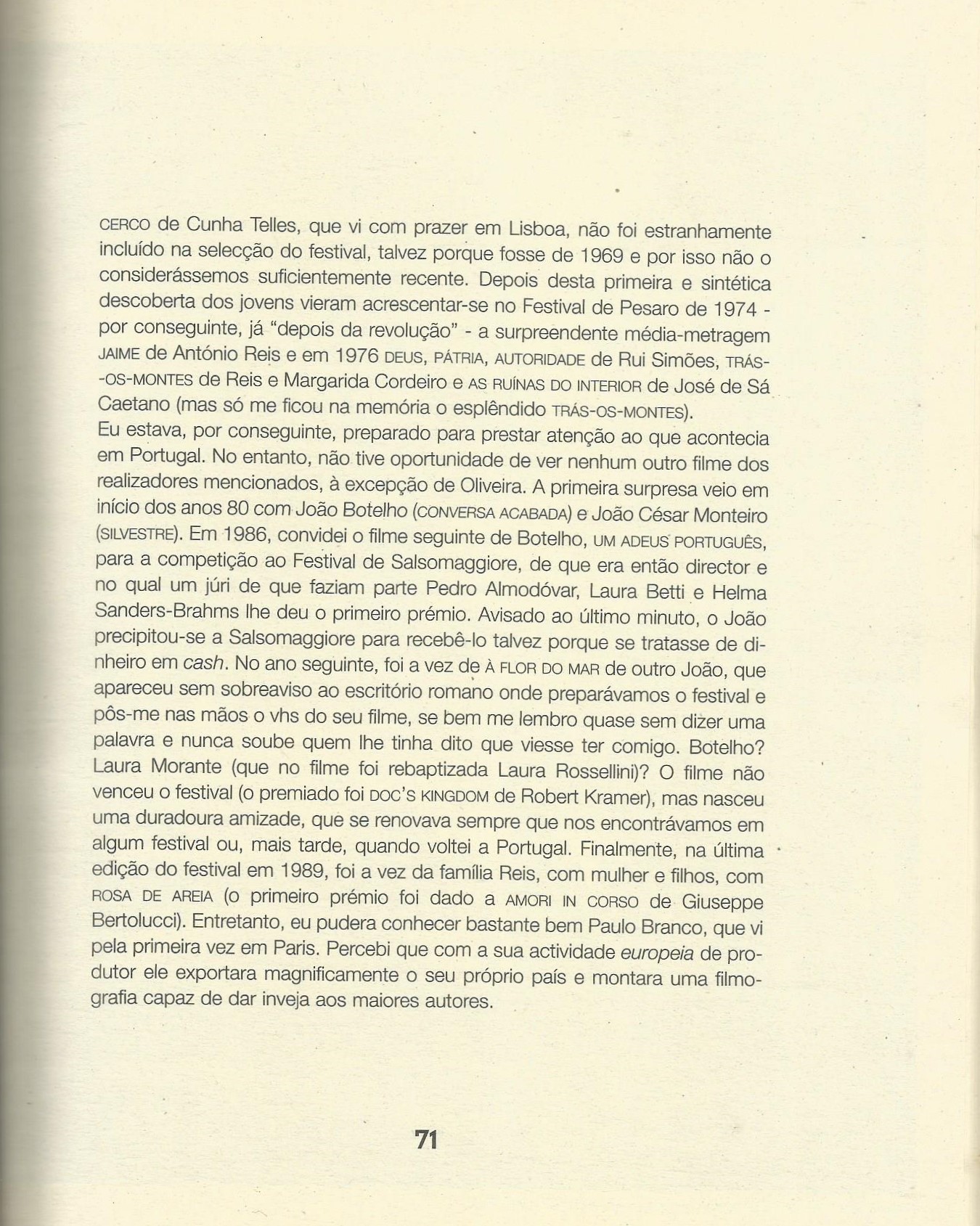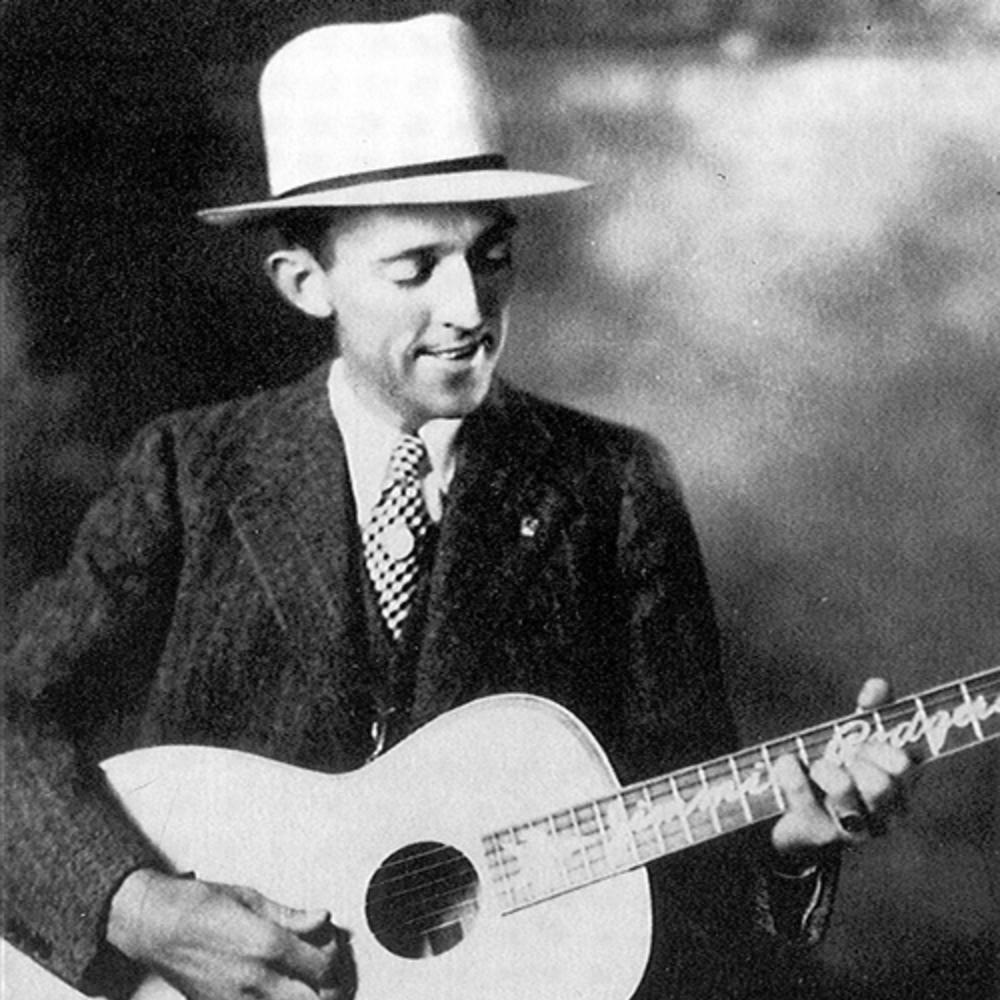sexta-feira, 28 de julho de 2023
terça-feira, 25 de julho de 2023
Stan Brakhage on Music, Sound, Color, and Film
Mid-April, 1966
Dear Ronna Page,
Jonas Mekas will have whatever material has been salvaged on and/or by me — old clips, "stills", etcetera — as I make a practice of sending them all to him for Film-Makers' Cooperative files.
As to quotes out of my past, I imagine you have ample material in Film Culture issues and my book Metaphors On Vision. I am presently working on a long film (16mm) to be called: Scenes From Under Childhood. It would probably be of particular interest to your Parisian readers to know that this work-in-progress is to some extent inspired by the music of Olivier Messiaen and, to some lesser extent, Jean Barraque, Pierre Boulez, Henri Pousseur, and Karlheinz Stockhausen (all, I believe, former pupils of Messiaen).
Fifteen years ago I began working with the film medium as primarily shaped by the influence of stage drama. Since that time, both poetry and painting have alternately proved more growth-engendering sources of inspiration than either the trappings of the stage or the specific continuity limitations of any "making up a story", novelistic tendencies, etcetera: and the first departures in my working-orders from "fiction" sources gave rise to an integral involvement with musical notation as a key to to film editing aesthetics. Some ten years ago I studied informally with both John Cage and Edgar Varese, at first with the idea of searching out a new relationship between image and sound and of, thus, creating a new dimension for the sound track, as Jean Isidore Isou's Venom and Eternity had created in me a complete dissatisfaction with the conventional usages of music for "mood" and so-called "realistic sounds" as mere referendum to image in movies, and Jean Cocteau's poetic film plays, for all their dramatic limitations, had demonstrated beautifully to me that only non-descriptive language could co-exist with moving image (in any but a poor operatic sense), that words, whether spoken or printed, could only finally relate to visuals in motion thru a necessity of means and/or an integrity as severely visual as that demonstrated by the masterpieces of collage. The more informed I became with aesthetics of sound, the less I began to feel any need for an audio accompaniment to the visuals I was making. I think it was seven/eight years ago I began making intentionally silent films. Although I have always kept myself open to the possibilities of sound while creating any film, and have in fact made a number of sound films these last several years, I now see/feel no more absolute necessity for a sound track than a painter feels the need to exhibit a painting with a recorded musical background. Ironically, the more silently-oriented my creative philosophies have become, the more inspired-by-music have my photographic aesthetics and my actual orders become both engendering a coming-into-being of the physiological relationship between seeing and hearing in the making of a work of art in film.
I find, with Cassius Keyser, that "the structure of mathematics is similar to that of the human nervous system" and have for years been studying the relationship between physiology and mathematics via such books as Sir D'Arcy Thompson's On Growth And Form: and following those "leads" along a line of music, I've come to the following thoughts (which I'll quote from an article of mine which appeared in the magazine Wild Dog):
I'm somehow now wanting to get deeper into my concept of music as sound equivalent of the mind's moving, which is becoming so real to me that I'm coming to believe the study of the history of music would reveal more of the changing though processes of a given culture than perhaps any other means — not of thought shaped and/or Thoughts but of the Taking shape, physiology of thought or some such . . . I mean is there anything that will illustrate the feel of chains of thought gripping and ungripping, rattling slowly around, a block-concept, an Ideal, as Gregorian Chant, for instance? . . . and doesn't The Break occur in Western Musical thought in terms of melody, story, carrying blocks, making them events, along a line? (Or, as poet Robert Kelly put it to me recently: & event is the greatness of story, i.e., where story and history & myth & mind & physiology all at once interact" — and is not THAT the greatness of Bach, the interaction of blocks becoming events as they inter eachother in the act, in the course, of the line of melody? (I'm reminded here that Gregorian notes WERE blocks in manuscript, stems attached later to make flowers of 'em, and then, still later, strung along lined paper, etcetera. And sometime later, when the notes were well rounded, flowering right-and-upside-down, sporting flags, holes, etc., and all planted in the neat gardens of the page, all in rows, it was possible for Mozart to play Supreme Gardener; but there lurked Wagner who would, did, make of each line of melody a block, specifically referential, so that the French could image melody as a landscape, all thought referential to picture, i.e. to something OUTside the musical frame of reference. But then Webern made of it a cube, all lines of melody converging on some center to form a cluster or what composer James Tenney, writing about Varese, does call "a Klang." And it does seem to me that with John Cage we are, thru chance operations, to some approximation of Gregorian Chant again — not held to links, as of a chain-of-thought, but rather to the even more rigid mathematical bell-shaped curve.
J.S. Bach has been called "the greatest composer of the 20th century'; and his current popularity is probably due to the facts that (1) he was the greatest composer of his own time and (2) most of the western world has, in the meantime, come to think easily in a baroque fashion — come to think naturally baroquely, one might say were it not that this process of thought is the result of these several centuries of cultural training. The most modern baroqueists in music were, of course, the twelve-tonists: and my Anticipation of The Night was specifically inspired by the relationships I heard between the music of J.S. Bach and Anton Webern. The crisis of Western Man's historical thought processes struggling with the needs of contemporary living (technological as against mechanistic) has never been more clearly expressed than in Webern's adaptation of Bach's "Musical Offering" (which piece has inspired several films of mine, most dramatically the sound film Blue Moses): but the most essentially optimistic (if I may use so psychological a word) force of musical thought has come from Debussy, Fauré, Ravel, Roussel, Satie and even Lili Boulanger, etcetera — all moving along a line of hearing into the inner ear (the sphere of "music of the spheres" being now consciously the human head) . . . just as all visual of The Illustrative have centered the occasions of their inspiration in the mind's eye (so-called "Abstract Painting" having a very concrete physiological basis in "closed eye vision").
I seek to hear color just as Messiaen seeks to see sounds. As he writes (in notes for the record of "Chronocromie"):
Colour: the sounds colour the durations because they are, for, bound to colour by unseen ties.
I find these "ties" to be sense impulses of the nervous system and find them to have exact physiological limitations but unlimited psychological growth potential thru the act of seeing and hearing, and/or otherwise sensing, them. Messiaen goes on:
When I listen to music, and even when I read it, I have an inward vision of marvellous colours — colours which blend like combinations of notes, and which shift and revolve with the sounds.
I recall first hearing shifting chords of sound that corresponded in meaningful interplay with what I was seeing when I was a child in a Kansas corn-field at mid-night. That was the first time I was in an environment silent enough to permit me to hear "the music of the spheres", as it's called, and visually specific enough for me to be aware of the eye's pulse of receiving image. John Cage once, in a sound-proof chamber, picked out a dominant fifth and was told later that he was hearing his nervous system and blood circulation: but the matter is a great deal more complicated than that — at least as much more complicated as the whole range of musical chord possibilities is to the, any dominant fifth . . . for instance, any tone of the inner- ear seems to be hearable as a pulse, or wave of that tone, of irregular rhythm and tempo, "waveringness" one might say: and yet these hearable pulse-patterns repeat, at intervals, and reverse, and etcetera, in a way analogous to the "theme and variation" patterns of some western musical forms. External sounds heard seem to affect these inner-ear pulses more by way of the emotions engendered than by specific tonal and/or rhythmic correspondences: whereas the external pulse perceived by the eye does seem to more directly affect ear's in-pulse. But then that's a much more complicated matter, too, because the eye has its own in-pulse — the color red, for instance, will be held, with the eyes closed, as a retetion-color with a much different vibrancy, or pulse, than red seen with the eyes open, and so on — and the rhythm-pattern-flashes of the eye's-nerve-ends, making up the grainy shapes of closed-eye vision, are quite distinct from inner-ear's "theme and variations" . . . so much so that no familiar counter-point is recognizable. Well, just SO — for these fields of the mind feeling out its own physiology via eyes and ears turned inward, so to speak, are prime centers of inspiration for both musical and visual composers of this century who take Sense as Muse (as do all who recognize the move from Technological to Electrical Era of 20th century living) . . . and there is very little historical precedence in the working orders, or the achievements, of these artists.
Well, all of the above essaying (which grew way beyond any intended length) should at least serve to distinguish my intentions and processes, and whatever films of mine arise there-thru, from most of the rest of the so-called Underground Film Movement: and (as you asked specifically about this in your letter) I'll take the opportunity to emphasize that I feel at polar odds and ends therefrom whatever usually arises from that "movement" into public print, especially when journalists and critcis are presuming to write about myself and my work. I'm certainly nothing BUT uneasy about the any/everybody's too facile sense of mixed-media, which seems by report to be dominating the New York Scene, at the present. Whether the "mix" is per chance (operations) or per romance (opera) or per some scientic stance (Op) or just plain folksy, Gran Ol' Opray, dance (Pop), I've very little actual interest in it, nor in The Old Doc- (umentary) school, with its "spoon full of sugar helps the medicine go down" either — all these socio-oriented effect-films being related to "The Cause" rather than Aesthetics . . . and some of them, naturally, working beautifully in that context; but most of them, these days, causing sensibility-crippling confusions in the long run, because all are sailing into import under the flag of "Art," leaving that term bereft of meaning and those films which are simply "beautiful works" (which will "do no work" but will "live forever," as Ezra Pound says of his songs) lacking the distinction that there IS that possibility for cinema, as established in all other arts, of works that can and must be seen many times, will last, have qualities of integrality to be shored against the dis-continuities of fashionable time. I do not ever like to see a "Cause" made of, or around, a work of art; and I strive to make films integrally cohesive enough to be impregnable to the rape of facile usage (shudder at the thought of Hitler shoveling eight million Jews into the furnace off the pages of "Thus Spake Zarathustra," etcetera, for instance). To be clear about it (and to answer another of your questions about my attitude toward increasing censorhip): I've many times risked jail sentences for showing films of mine which were, at the time, subject to sexual censorhip laws, and will do so again if the occasion arises: but I have never, and will never, force said works upon an unprepared or antagonistic audience, have never made them party-to/subject-of (and/or)/illustration-for "The Cause of Sexual Freedom" or some-such. I made those films, as all my films, out of personal necessity taking shape thru means available to me of historical aesthetics. I risked imprisonment showing them in order to meet the, as requested, needs of others. To have forced these works upon others, because of my presumption of the good-for-them in such occasion, would have been to blaspheme agaisnt the process out of which the works arise and to have eventually destroyed myself as instrument of that process . . . freedom, of expression-or-other, can only exist meaningfully out of full respect to the means of its becoming: and a work of art does never impress, in the usual sense of the word, but rather is free-express always — and it does, therefore, require some free space, some fragile atmosphere of attenuated sensibility, in which to be received . . . the social strength of the arts is rooted in human need to freely attend, which demonstrates itself over and over again in that people finally DO create such an UNlikely (free of all likenesses) space wherein aesthetics (shaped with respect to his/somebody-else's and history's means) can be received. Let society's sex-pendulum swing "anti" again, if it will (tho' I hope it won't), the works of art of sex impulse will continue to be made as surely as babies and to have an eventual public life as surely as babies grow up.
Blessings,
Stan Brakhage
Film Culture n° 67-68-69, 1979
segunda-feira, 24 de julho de 2023
domingo, 23 de julho de 2023
sexta-feira, 21 de julho de 2023
Blues anti-blues
Tastes without clichés
I started directing in 1932—was editing from 1928 to 1932. I was a contract director to Pathé-Natan, paid by the month, and I was directing features and I was getting around $50 a week which wasn’t much money. And we hadn’t been married too long—my wife and I—and of course I had been brought up in California and I went to school there, I liked the climate. And I made a mistake—I thought it would be very easy, I could quickly get a film in Hollywood having done four features in France. So we just packed up and took a chance. We said we’Il go over there—if it doesn’t work we can always come back. Then it took me a year or two—I had to do second units, but even doing second units MGM was paying me $100 a week which was twice what I was doing features for.
I worked for three months [on A Tale of Two Cities] — we had a unit which was called the French Revolutionafy Unit of which Val Lewton was the producer. I was the director. We had our own script which Val Lewton wrote which had to do with all the storming of the Bastille, that bit of it. So we were responsible for that and I shot 10 or 11 days. That’s how we met Then Lewdon went to RKO as a producer, he asked for me and we did The Cat People and a few other films.
The Department of Justice asked Mr. Louis B. Mayer if he would make in his short subjects a two-reel subject about the Federal Penitentiaries. So since I was doing shorts they sent me to five or six . . . all over the United States. Then Mr John Higgins wrote a two-reel Crime Does Not Pay story with actors about that. The two-reel thing comes out and Mr. Louis B. Mayer looks at it and says, 'This is interesting. We’re now doing featurettes, we’re going to do four-reel films to complete the programme.’ They said call back Johnny Higgins and write two more reels. So we had an awful time getting the actors together. They were all over the place. We had to wait a month or two before we could get them all together.
We cut that together—three months go by—Mr. Mayer looks at it: ‘This is four reels—this shouldn’t be a featuretter—this should be six reels and be a full-length feature.’ We wait, get all the actors together again and we finished with a full length feature called They All Come Out which unbelievably made good sense. Looking at it you’d never think it was first two reels, then four reels, then six reels. It was a tour de force on the part of Mr. John C. Higgins and that’s how I did my first feature, at MGM. Then they put me into Nick Carters and those things.
I did the first two Nick Carters and then they made more and I left and went to RKO. The first A feature was the one with Gregory Peck [Days of Glory] — that was a very big budget. There were 35 people in it, not one of whom had ever been on any screen beforer—an experiment by Casey Robinson. There was one exception—Hugo Haas had in Hungary or wherever he was made one or two little silent films. In those days they were exalting the Great Russian Guerilla. Four years later it was anathema.
All B fiIms and especially horror film in those days were done in terrible taste—a general lack of taste. Val Leyton we a man of innate good taste and we worked beautifully together. I think Cat People was a bit above the average and so was I Walked With A Zombie. I Walked With A Zombie was to me the best. It was very poetic—a horrrible title. The film had nothing to do with the title. It was all at night and it was an authentic, documentary approach to voodoo in Haiti. We showed the real voodoo rites — we had real voodoo people come in. We used for the first time in any fitm a calypso singer—he told the story. It began and whenever we were having a dramatic scene somewhere in the street at night he’d go by singing and he was observing this drama going on and telling us, just like the old Greek tragedies. This gave a wonderful poésie to the film. It was Jane Eyre really. We were looking for a subject—well, it was public domain so we said let‘s take Jane Eyre and put it in Haiti with a voodoo singer.
I shot the picture very quickly and the picture came out. Nobody saw it, nobody saw this picture. It had a bad title, it's the best picture I've ever done, the one I like the best. I didn't get any money and it lowered my price. I was way down, I couldn't get any more money, but it was worth it because I loved every bit of that picture.
My favourite film for years and years and years is Lilies of the Field. It was a 12-day thing. It cost nothing. I voted for that at the Academy as Best Picture of the Year. I don't see many films. I do at the Academy—once a year I see about 30 or 40 in the spring when we vote. I saw Tom Jones three times and liked it better the third time.
This director Sam Peckinpah worked with me as dialogue director on one or two films—he was on Wichita and he always said he admired my style on Wichita. He was very anxious to become a director and by accident one day I was downtown in Los Angeles and I had nothing to do and I saw Ride the High Country [Guns in the Afternoon]—it was just great. It was John Ford when John Ford was good, 10-15 years ago. It was the first honest western I'd seen in years and years and years. I'm very anxious to see Major Dundee.
I'm a great, great believer—I'm not a nut on this subject but I've been a student for forty years—I'm a great believer in parallel worlds — you know, to do with vibrations—which I'm certain of. I've never in my whole life initiated a film—I've always taken what they've given to me. But I'm starting now.
There is a parallel world. I want to show it. I'd like to make almost a documentary on parapsychology—using actors. I'm going to use all the scientific things as against ghosts. I'm going to make my own mistakes now. I'm either going to make a great film or a terrible film.




